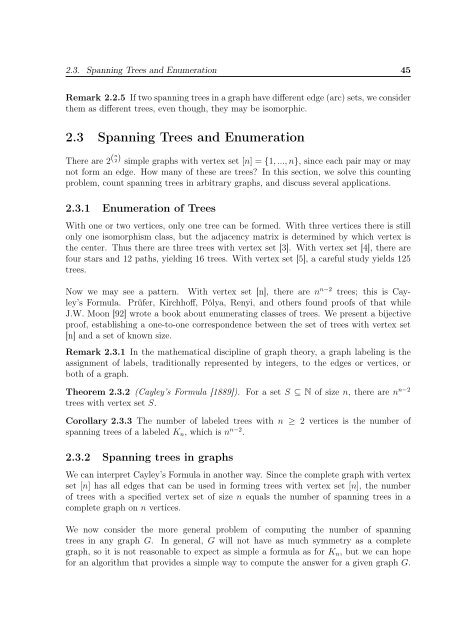enumeration of the number of spanning trees in some ... - Toubkal
enumeration of the number of spanning trees in some ... - Toubkal
enumeration of the number of spanning trees in some ... - Toubkal
You also want an ePaper? Increase the reach of your titles
YUMPU automatically turns print PDFs into web optimized ePapers that Google loves.
2.3. Spann<strong>in</strong>g Trees and Enumeration 45Remark 2.2.5 If two <strong>spann<strong>in</strong>g</strong> <strong>trees</strong> <strong>in</strong> a graph have different edge (arc) sets, we consider<strong>the</strong>m as different <strong>trees</strong>, even though, <strong>the</strong>y may be isomorphic.2.3 Spann<strong>in</strong>g Trees and EnumerationThere are 2 (n 2) simple graphs with vertex set [n] = {1, ..., n}, s<strong>in</strong>ce each pair may or maynot form an edge. How many <strong>of</strong> <strong>the</strong>se are <strong>trees</strong>? In this section, we solve this count<strong>in</strong>gproblem, count <strong>spann<strong>in</strong>g</strong> <strong>trees</strong> <strong>in</strong> arbitrary graphs, and discuss several applications.2.3.1 Enumeration <strong>of</strong> TreesWith one or two vertices, only one tree can be formed. With three vertices <strong>the</strong>re is stillonly one isomorphism class, but <strong>the</strong> adjacency matrix is determ<strong>in</strong>ed by which vertex is<strong>the</strong> center. Thus <strong>the</strong>re are three <strong>trees</strong> with vertex set [3]. With vertex set [4], <strong>the</strong>re arefour stars and 12 paths, yield<strong>in</strong>g 16 <strong>trees</strong>. With vertex set [5], a careful study yields 125<strong>trees</strong>.Now we may see a pattern. With vertex set [n], <strong>the</strong>re are n n−2 <strong>trees</strong>; this is Cayley’sFormula. Prüfer, Kirchh<strong>of</strong>f, Pólya, Renyi, and o<strong>the</strong>rs found pro<strong>of</strong>s <strong>of</strong> that whileJ.W. Moon [92] wrote a book about enumerat<strong>in</strong>g classes <strong>of</strong> <strong>trees</strong>. We present a bijectivepro<strong>of</strong>, establish<strong>in</strong>g a one-to-one correspondence between <strong>the</strong> set <strong>of</strong> <strong>trees</strong> with vertex set[n] and a set <strong>of</strong> known size.Remark 2.3.1 In <strong>the</strong> ma<strong>the</strong>matical discipl<strong>in</strong>e <strong>of</strong> graph <strong>the</strong>ory, a graph label<strong>in</strong>g is <strong>the</strong>assignment <strong>of</strong> labels, traditionally represented by <strong>in</strong>tegers, to <strong>the</strong> edges or vertices, orboth <strong>of</strong> a graph.Theorem 2.3.2 (Cayley’s Formula [1889]). For a set S ⊆ N <strong>of</strong> size n, <strong>the</strong>re are n n−2<strong>trees</strong> with vertex set S.Corollary 2.3.3 The <strong>number</strong> <strong>of</strong> labeled <strong>trees</strong> with n ≥ 2 vertices is <strong>the</strong> <strong>number</strong> <strong>of</strong><strong>spann<strong>in</strong>g</strong> <strong>trees</strong> <strong>of</strong> a labeled K n , which is n n−2 .2.3.2 Spann<strong>in</strong>g <strong>trees</strong> <strong>in</strong> graphsWe can <strong>in</strong>terpret Cayley’s Formula <strong>in</strong> ano<strong>the</strong>r way. S<strong>in</strong>ce <strong>the</strong> complete graph with vertexset [n] has all edges that can be used <strong>in</strong> form<strong>in</strong>g <strong>trees</strong> with vertex set [n], <strong>the</strong> <strong>number</strong><strong>of</strong> <strong>trees</strong> with a specified vertex set <strong>of</strong> size n equals <strong>the</strong> <strong>number</strong> <strong>of</strong> <strong>spann<strong>in</strong>g</strong> <strong>trees</strong> <strong>in</strong> acomplete graph on n vertices.We now consider <strong>the</strong> more general problem <strong>of</strong> comput<strong>in</strong>g <strong>the</strong> <strong>number</strong> <strong>of</strong> <strong>spann<strong>in</strong>g</strong><strong>trees</strong> <strong>in</strong> any graph G. In general, G will not have as much symmetry as a completegraph, so it is not reasonable to expect as simple a formula as for K n , but we can hopefor an algorithm that provides a simple way to compute <strong>the</strong> answer for a given graph G.

















